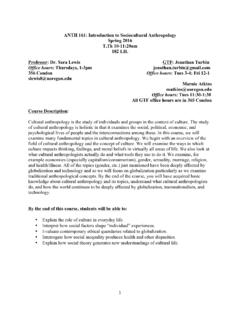Transcription of Architecture: Form, Space, And Order, 3rd Edition
1 1834 Organization .. A good house is a single thing, as well as a collection of many, and to make it requires a conceptual leap from the individual components to a vision of the whole. The choices .. represent ways of assembling the .. the basic parts of a house can be put together to make more than just basic parts: They can also make space, pattern, and outside domains. They dramatize the most elementary act which architecture has to perform. To make one plus one equal more than two, you must in doing any one thing you think important (making rooms, putting them together, or fitting them to the land) do something else that you think important as well (make spaces to live, establish a meaningful pattern inside, or claim other realms outside). Charles Moore, Gerald Allen, Donlyn LyndonThe Place of Houses1974 184 / ARCHITECTURE: FORM, SPACE, & ORDERThe last chapter laid out how various configurations of form could be manipulated to define a solitary field or volume of space, and how their patterns of solids and voids affected the visual qualities of the defined space.
2 Few buildings, however, consist of a solitary space. They are normally composed of a number of spaces which are related to one another by function, proximity, or a path of movement. This chapter lays out for study and discussion the basic ways the spaces of a building can be related to one another and organized into coherent patterns of form and , Palace and Citadel of the Moorish kings, Granada, Spain, 1248 1354 ORGANIZATION OF FORM AND SPACE ORGANIZATION / 185 Space within a SpaceA space may be contained within the volume of a larger SpacesThe field of a space may overlap the volume of another SpacesTwo spaces may abut each other or share a common Linked by a Common SpaceTwo spaces may rely on an intermediary space for their RELATIONSHIPSTwo spaces may be related to each other in several fundamental ways.
3 186 / ARCHITECTURE: FORM, SPACE, & ORDERA large space can envelop and contain a smaller space within its volume. Visual and spatial continuity between the two spaces can be easily accommodated, but the smaller, contained space depends on the larger, enveloping space for its relationship to the exterior this type of spatial relationship, the larger, enveloping space serves as a three-dimensional field for the smaller space contained within it. For this concept to be per-ceived, a clear differentiation in size is necessary between the two spaces. If the contained space were to increase in size, the larger space would begin to lose its impact as an enveloping form. If the contained space continued to grow, the residual space around it would become too com-pressed to serve as an enveloping space. It would become instead merely a thin layer or skin around the contained space.
4 The original notion would be endow itself with a higher attention-value, the contained space may share the form of the enveloping shape, but be oriented in a different manner. This would create a secondary grid and a set of dynamic, residual spaces within the larger contained space may also differ in form from the enveloping space in order to strengthen its image as a freestanding volume. This contrast in form may indicatea functional difference between the two spaces or the symbolic importance of the contained WITHIN A SPACE ORGANIZATION / 187 Moore House, Orinda, California, 1961, Charles MooreGlass House, New Canaan, Connecticut, 1949, Philip JohnsonSPACE WITHIN A SPACE 188 / ARCHITECTURE: FORM, SPACE, & ORDERAn interlocking spatial relationship results from the overlapping of two spatial fields and the emergence ofa zone of shared space.
5 When two spaces interlock their volumes in this manner, each retains its identity and definition as a space. But the resulting configuration of the two interlocking spaces is subject to a number of interlocking portion of the two volumes canbe shared equally by each interlocking portion can merge with one of the spaces and become an integral part of its interlocking portion can develop its own integrity as a space that serves to link the two original SPACES ORGANIZATION / 189 Plan for St. Peter (Second Version), Rome, 1506 1520, Donato Bramante & Baldassare PeruzziPilgrimage Church, Vierzehnheiligen, Germany, 1744 72, Balthasar NeumannVilla at Carthage, Tunisia, 1928, Le CorbusierINTERLOCKING SPACESThe one-story space flows into the larger volume of which it is a part and to the outdoors. 190 / ARCHITECTURE: FORM, SPACE, & ORDERA djacency is the most common type of spatial relation-ship.
6 It allows each space to be clearly defined and to respond, each in its own way, to specific functional or symbolic requirements. The degree of visual and spatial continuity that occurs between two adjacent spaces depends on the nature of the plane that both separates and binds them separating plane may: limit visual and physical access between two adjacent spaces, reinforce the individuality of each space, and accommodate their differences. appear as a freestanding plane in a single volumeof space. be defined with a row of columns that allows a high degree of visual and spatial continuity between the two spaces. be merely implied with a change in level or a contrast in surface material or texture between the two spaces. This and the preceding two cases can also be read as single volumes of space which are divided into two related SPACES ORGANIZATION / 191 Three spaces the living, fireplace, and dining areas are defined by changes in floor level, ceiling height, and quality of light and view, rather than by wall Design, 17th century, Fischer von ErlachChiswick House, Chiswick, England, 1729, Lord Burlington & William KentUpper LevelMain LevelLawrence House, Sea Ranch, California, 1966, Moore-Turnbull/MLTWThe spaces in these two buildings are individualistic in size, shape, and form.
7 The walls that enclose them adapt their forms to accommodate the differences between adjacent LevelADJACENT SPACES 192 / ARCHITECTURE: FORM, SPACE, & ORDERTwo spaces that are separated by distance can be linkedor related to each other by a third, intermediate, visual and spatial relationship between the two spaces depends on the nature of the third space with which they share a common intermediate space can differ in form and orientation from the two spaces to express its linking two spaces, as well as the intermediate space, canbe equivalent in size and shape and form a linear sequence of intermediate space can itself become linear in form to link two spaces that are distant from each other, or join a whole series of spaces that have no direct relationship to one intermediate space can, if large enough, becomethe dominant space in the relationship.
8 And be capable of organizing a number of spaces about form of the intermediate space can be residualin nature and be determined solely by the forms and orientations of the two spaces being LINKED BY A COMMON SPACE ORGANIZATION / 193 Palazzo Piccolomini, Pienza, Italy, c. 1460,Bernardo RosselinoCaplin House, Venice, California, 1979, Frederick FisherOne-half House (Project), 1966, john HejdukSPACES LINKED BY A COMMON SPACE 194 / ARCHITECTURE: FORM, SPACE, & ORDERThe following section lays out the basic ways we can arrange and organize the spaces of a building. In a typical building program, there are usually requirements for various kinds of spaces. There may be requirements for spaces that: have specific functions or require specific forms are flexible in use and can be freely manipulated are singular and unique in their function or significance to thebuilding organization have similar functions and can be grouped into a functional clusteror repeated in a linear sequence require exterior exposure for light, ventilation, outlook, or accessto outdoor spaces must be segregated for privacy must be easily accessibleThe manner in which these spaces are arranged can clarify their relative importance and functional or symbolic role in the organization of a building.
9 The decision as to what type of organization to use in a specific situationwill depend on: demands of the building program, such as functional proximities, dimensional requirements, hierarchical classification of spaces, and requirements for access, light, or view exterior conditions of the site that might limit the organization s formor growth, or that might encourage the organization to address certain features of its site and turn away from othersSPATIAL ORGANIZATIONSC ompositions of Nine Squares: A Bauhaus Study ORGANIZATION / 195 Each type of spatial organization is introduced by a section that discussesthe formal characteristics, spatial relationships, and contextual responses of the category. A range of examples then illustrates the basic points made in the introduction. Each of the examples should be studied in terms of:Centralized OrganizationA central, dominant space about which a number of secondaryspaces are groupedLinear OrganizationA linear sequence of repetitive spacesRadial OrganizationA central space from which linear organizations of spaceextend in a radial mannerClustered OrganizationSpaces grouped by proximity or the sharing of a common visualtrait or relationshipGrid OrganizationSpaces organized within the field of a structural grid or otherthree-dimensional framework What kinds of spaces are accommodated and where?
10 How are they defined? What kinds of relationships are established among the spaces, one to another, and to the exterior environment? Where can the organization be entered and what configuration does thepath of circulation have? What is the exterior form of the organization and how might it respond toits context?SPATIAL ORGANIZATIONS 196 / ARCHITECTURE: FORM, SPACE, & ORDERA centralized organization is a stable, concentrated composition that consistsof a number of secondary spaces grouped around a large, dominant, central central, unifying space of the organization is generally regular in form and large enough in size to gather a number of secondary spaces about its secondary spaces of the organization may be equivalent to one another in func-tion, form, and size, and create an overall configuration that is geometrically regular and symmetrical about two or more secondary spaces may differ from one another in form or size in order to respond to individual requirements of function, express their relative importance, or acknowledge their surroundings.













